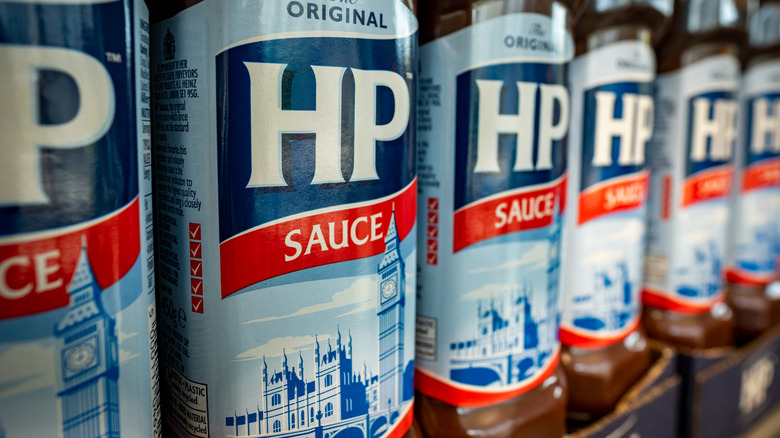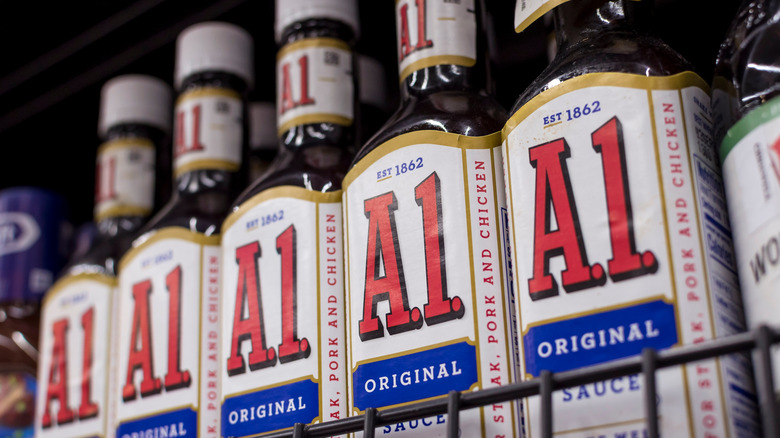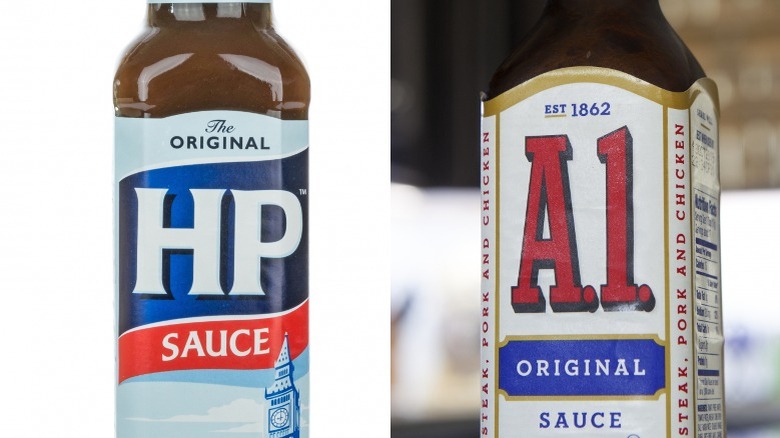What Is HP Brown Sauce (& Is It The Same As American Steak Sauce)?
The British people have pantries full of condiments that they can call their own, from the nutty-tasting malt vinegar made with dried barley grains to the fierce Colman's Mustard and the widely popular Worcestershire sauce. But of all these, none have quite reached cult status as HP Sauce, which Brits affectionately refer to simply as "brown sauce."
HP Sauce is the OG of British condiments, developed by a grocer named Frederick Gibson Garton in 1884, who gathered up tomatoes, dates, molasses, and soy — along with the more exotic tamarind — before blending that together with other fruits, spices, and malt vinegar to create what he had originally called "The Banquet Sauce." And because Garton had heard that his sauce was being served at the Houses of Parliament or H.P. he decided to rename his concoction Garton's H.P. Sauce."
Unfortunately, debt saw Garton part ways with his recipe in 1903, which was sold to the Midlands Vinegar Factory for just 150 British pounds. The new owners kept the name and added an illustration of Big Ben and the Palace of Westminster on it the bottle, which fans still see to this day. HP Sauce was invaluable to the British public, particularly in times of war and shortages, when it was needed to improve the flavor of their food. For a time, HP Sauce was also known as "Wilson's Gravy" because former prime minister Harold Wilson reportedly drenched all his meals in it.
The story behind A.1. sauce
When Americans think of steak sauce, the first thing that comes to mind is A.1. Original Sauce (once known as A.1. Steak Sauce), even though its origins are as British as HP Sauce. However, A.1. sauce has something HP doesn't — a Royal pedigree and a Royal seal of approval. The sauce was invented by Henderson William Brand, who was a chef for King George IV in the 1820s. The name was said to have been coined by the monarch because when he tried it, he described the sauce as "A.1."
It took a few years before Brand would begin making the sauce to sell to the public, and like HP Sauce, A.1. became popular because it did the job of camouflaging undesirable flavors, most notably beef that was on the verge of going bad. But the invention didn't exactly bring Brand wealth and luck, because he had gone bankrupt by 1850. As a result Brand's company — and his A.1. formula — changed hands several times. By the time the 1900s had come around, the sauce's name and its formula had been trademarked in the U.S., and by 1906 the product itself began appearing in the States.
What makes HP and A.1. different
While both HP and A.1. may seem like copycat recipes of each other, the only similarity they share is that they are both tinted brown. HP Sauce's ingredients are tomatoes, malt vinegar, molasses, glucose-fructose syrup, spirit vinegar, sugar, dates, cornflour, rye flour, salt, spices, flavoring, and tamarind. While A.1.'s ingredients are tomato puree, vinegar, corn syrup, salt, raisin paste, crushed orange puree, and spices including dried onions and celery seeds, as well as potassium sorbate and xanthan gum.
Each sauce has one ingredient that sets it apart from the others. In the case of A.1. that would come from raisin paste, and in the case of HP, which is slightly sweeter, the differentiator will come because of the addition of tamarind. Some have compared the flavor of HP to Worcestershire sauce, which is versatile enough to be enjoyed with a wide range of dishes, from savory pies to sandwiches. So, if you're lucky enough to find both in your local supermarket, we don't think it would be unusual to stock both at home. They might look the same, but you'll likely have diners that will prefer brown sauce over steak sauce and vice versa.


